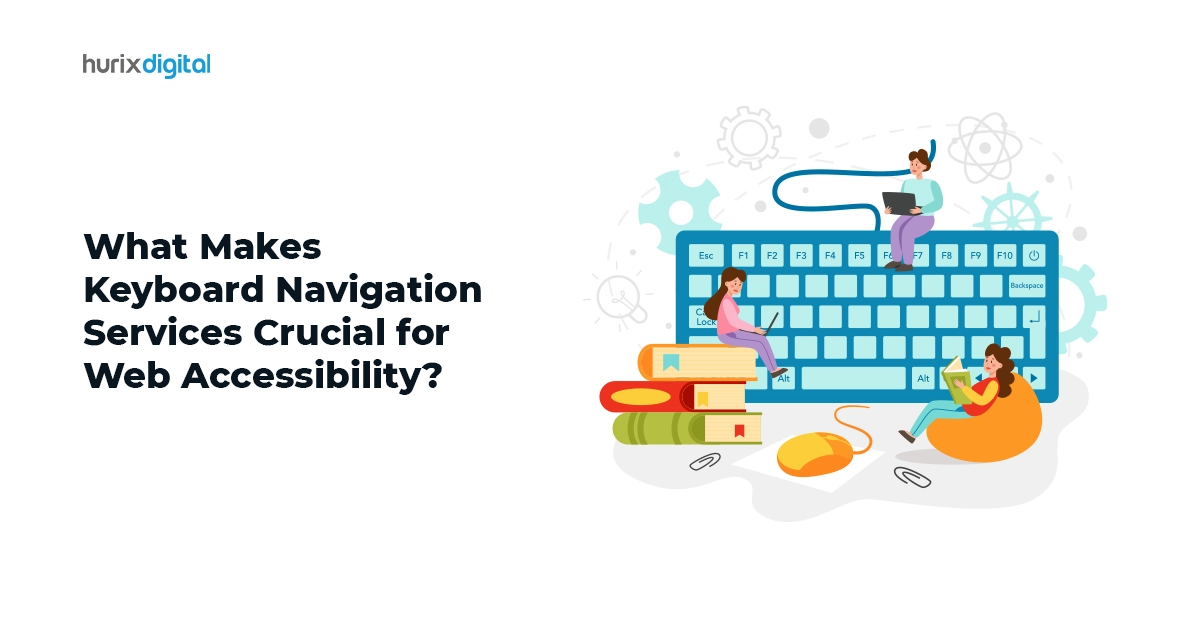Summary
This informative post explains why keyboard navigation is an essential accessible feature enabling the digital independence of motor-disabled users. It provides standards-aligned best practices to integrate keyboard compatibility into websites to empower inclusive usage solely through key presses.
In the rapidly evolving digital landscape, the quest for inclusivity has become a cornerstone of web development. One of the key players in ensuring a seamless and accessible online experience is keyboard navigation. In this informative blog, we’ll explore why keyboard navigation services are crucial for web accessibility, shedding light on the importance of accessibility standards, features, and guidelines set by WCAG (Web Content Accessibility Guidelines) to foster digital inclusion.
Table of Contents
- Keyboard Navigation: A Pillar of Accessibility
- The Role of Accessibility Features
- Why is Keyboard Navigation Important for Web Accessibility?
- How Can You Make Websites Keyboard Accessible?
- What Makes a Website’s Navigation Accessible?
- How Do You Use Keyboard-Only Navigation for Web Accessibility?
- Conclusion
Let’s explore what constitutes accessible keyboard-driven navigation and why it’s fundamental for digital inclusion.
Keyboard Navigation: A Pillar of Accessibility
1. Accessibility Standards and Keyboard Navigation
To truly comprehend the importance of keyboard navigation, it’s essential to understand its alignment with accessibility standards. These standards, often embodied in the Web Content Accessibility Guidelines (WCAG), set the criteria for making web content accessible. Keyboard navigation, being one of the fundamental accessibility features, plays a central role in meeting these standards.
2. Embracing Digital Inclusion
Digital inclusion is a key principle of web accessibility. It emphasizes the need to design and develop online spaces that cater to everyone, irrespective of their abilities or disabilities. Keyboard navigation services contribute significantly to this ethos, ensuring that users can navigate a website seamlessly without solely relying on a mouse or touch-based input.
The Role of Accessibility Features
1. Enhancing User Experience
Keyboard navigation is not just about meeting compliance standards; it’s about enhancing the user experience for everyone. A website that seamlessly accommodates keyboard navigation becomes more user-friendly for individuals with various abilities. It creates a more efficient and intuitive browsing experience, contributing to overall customer satisfaction.
2. Digital Inclusion Through Keyboard Navigation
Digital inclusion is a core aspect of web accessibility. By prioritizing digital inclusion through keyboard navigation services, websites become welcoming spaces for users with disabilities. This inclusivity is not only a legal and ethical obligation but also a strategic move for businesses to tap into a larger audience and foster a positive brand image.
Why is Keyboard Navigation Important for Web Accessibility?
Web accessibility standards like WCAG 2.1 mandate keyboard compatibility to ensure website usability for motor-impaired users. Relying solely on pointer devices like a mouse would exclude users unable to operate them effectively.
Instead, optimizing websites for seamless keyboard navigation gives motor-impaired users autonomy in accessing web content via pressing keys alone. This aids users with limited fine motor function, trembling, or those temporarily unable to use hands, like arthritis patients. Users operating devices lacking pointer input, like smart TVs or switches, also benefit.
With convenient keyboard navigation, websites become more perceptible, operable and robust for motor-disabled audiences. This prevents exclusion and sustains digital independence.
Also read: All You Need to Know about the European Accessibility Act 2025 and WCAG
How Can You Make Websites Keyboard Accessible?
When planning and developing sites, keep keyboard navigation ease at the core right from the start. Here are some accessibility guidelines and checks:
- Logical page sequence: Structure page elements properly so users can tab through them in a meaningful order.
- Visible focus indicator: Ensure active elements clearly highlight when tabbed to via keyboard.
- No keyboard traps: No elements should be impossible to move to or from using only a keyboard.
- All functions available: Users should be able to access all content and functions with key presses alone. For complex elements like carousels, provide extra shortcuts.
- Customizable timings: Lengthen or turn off timings that force unintended actions like session timeouts or element closures affecting key navigation.
By ensuring website interactions never depend solely on hovering, dragging or other pointer-specific actions, keyboard ease remains intact.
What Makes a Website’s Navigation Accessible?
Accessible navigation allows seamless location of pages and elements, contributing to an operable, perceivable and understandable site. Essentials include:
- Logical structure with navigational headings and paragraphs.
- Descriptive informative links. Links must convey purpose and be unique for context.
- Consistent placement of menus, search and sitemap.
- Structured identification of current page location.
- Expand/collapse sections to minimize scrolling barriers.
- No reliance on sensory qualities like shape or color alone to distinguish navigation paths.
Such navigation mechanisms customized for keyboard usability empower users to effectively find desired page areas and elements via key presses.
Also read: Whitepaper: WCAG – The Road to Making Businesses Accessible
How Do You Use Keyboard-Only Navigation for Web Accessibility?
Keyboard shortcuts and actions replacing mouse functions facilitate accessible usage across websites. Common input mechanisms enabling key-driven control include:
- Tab key to move forwards through interactive elements.
- Shift + Tab for moving backwards.
- Enter to select or follow links/buttons.
- Spacebar as an alternative select option.
- Esc to close pop-ups and lightboxes without a pointer.
- Alt + Accesskey for custom site functions if provided.
- Arrow keys replace hovering in menus, carousels etc.
These keys used singly or in combination give users precision movement between sections, options and actions.
Test navigation efficiency by trying popular keyboard shortcuts yourself. Tools like screen readers coupled with vocalization of control actions also aid testing from a differently-abled user perspective to spot navigation difficulty areas if any.
Strive for Keyboard Inclusivity as Standard Practice
Constructing accessibility into web presence including via decking out sites with keyboard navigation functionality should become second nature rather than an afterthought. Treat accessibility as you would scalability or security – a non-negotiable best practice built right into web frameworks and processes from the ground up.
WCAG guidelines coupled with ongoing automated and manual testing help ingrain web accessibility including effective keyboard navigation as part of business as usual across teams – designers, writers, developers and testers alike.
Also read: WCAG 2.1 Compliance Guidelines: All You Need to Know
Conclusion
The importance of keyboard navigation services in achieving web accessibility cannot be overstated. It’s a fundamental aspect of creating an inclusive online environment where everyone can navigate, interact, and access information regardless of their abilities. As we navigate the digital landscape, let’s ensure that the journey is accessible to all.
If a website audit reveals room for bettering web accessibility standards compliance, especially around keyboard navigation services, support from experts like Hurix Digital can get you there smoothly. Our user-centric accessibility features uplift websites towards inclusivity leaving no user behind!
Contact Us to Know More.











